 Narrowsburg
NarrowsburgLight Rain Fog/Mist, 43°
Wind: 8.1 mph
 Narrowsburg
NarrowsburgBETHEL, NY — The morning started with a yogurt tasting. This reporter is not particularly fond of yogurt, but the sample provided was quite good. The yogurt was the result of a process that …
Stay informed about your community and support local independent journalism.
Subscribe to The River Reporter today. click here
This item is available in full to subscribers.
Please log in to continue |


BETHEL, NY — The morning started with a yogurt tasting. This reporter is not particularly fond of yogurt, but the sample provided was quite good. The yogurt was the result of a process that began for Melinda Meddaugh of Cornell Cooperative Extension in January 2014, and involved many people at the state and county level, with extensive participation by the Sullivan County Department of Planning and other departments.
The yogurt manufacturing facility, which is part of the Bethel Creamery, was aided by a grant of $186,000 from the United States Department of Agriculture, and a grant of $100,000 came from the state. Many town and county officials attended the ribbon-cutting ceremony.
The farm belongs to the Franklin family, and they realized that the only way to have a successful dairy farm in this very tough dairy environment is to add value by further processing some of the milk on the farm.
Eli Franklin said the family started a small bottling operation for their milk six years ago. “We started pasteurizing milk right here on the farm.” He said the family’s process is a little unique. “For the most part, milk is pasteurized at a higher temperature, which kills off more of the good and bad bacteria, and gives the milk a longer shelf life. We put in a vat pasteurizer, which allows us to pasteurize at a lower temperature, and although it may give the milk a little bit shorter shelf life, the milk maintains the healthy bacteria, the bacteria that is good for us. It’s a much better quality milk.”
He said the family bottles about 600 or 700 bottles a week; everything else is still going off to the milk co-op.
In the yogurt-making process, after the milk has been pasteurized, it’s pumped into a 100-gallon tank where it is heated to 180° Fahrenheit and held for 30 minutes. Then the temperature is brought down to 105°, cultures are added, and the mixture sits for several hours.
Franklin said, “Once bacteria consumes the milk, it curdles and becomes yogurt, and can be bottled.” The plan is to sell the yogurt in stores in various locations, which is how the milk is sold now.
After the yogurt operation is up and running, the family plans to move into making cheese, and they already have the necessary equipment.
Comments
No comments on this item Please log in to comment by clicking here